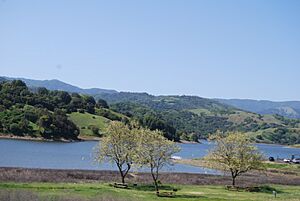Guadalupe watershed facts for kids
The Guadalupe watershed is a large area of land, about 170 square miles (400 km2) (440 square kilometers), located in Santa Clara County, in northern California. Think of a watershed as a giant funnel where all the rain and water from creeks and rivers eventually flow into one main body of water. For the Guadalupe watershed, all this water ends up in the San Francisco Bay.
This important area is looked after by the Santa Clara Valley Water District. All the water from creeks and rivers, and even from storm drains, flows into the Guadalupe River. From there, it travels downstream and empties into the San Francisco Bay at a place called Alviso Slough in Alviso.
The main creeks that feed into the Guadalupe River include Los Gatos Creek, Trout Creek, Hendrys Creek, Ross Creek, Pheasant Creek, Rincon Creek, Herbert Creek, and Golf Creek. There are also six big reservoirs in the watershed: Calero Reservoir, Guadalupe Reservoir, Almaden Reservoir, Vasona Reservoir, Lexington Reservoir, and Lake Elsman.
The Guadalupe watershed covers parts of several nearby cities, such as San Jose, Los Gatos, Monte Sereno, Campbell, and Santa Clara.
Contents
Mercury Contamination Concerns
The Guadalupe watershed was a very busy place during the California Gold Rush. Because of this history, there are concerns about mercury in the area. Mercury is a metal that was used by miners because it could easily stick to gold. Miners would often use mercury in their equipment to help separate gold from other materials.
It's estimated that about 6,500 tons of mercury were lost into the creeks and rivers along the coast between 1850 and 1920. Even today, traces of this mercury can still be found in the water, in animals, and in the riverbeds of these affected waterways.
How Mercury Affects the Environment
When mercury gets into rivers and lakes, it can change into a more dangerous form called methylmercury. This happens when tiny living things called bacteria in the water convert the mercury. Methylmercury is more toxic than regular mercury.
One big problem with methylmercury is how it moves up the food chain. This process is called biomagnification.
- Small insects and other tiny creatures in the water can take in methylmercury.
- Fish then eat these small creatures.
- Larger fish eat the smaller fish.
- And finally, humans might eat the fish.
At each step, the amount of methylmercury gets higher and higher in the animals. This means that animals higher up in the food chain, like big fish, birds, and mammals that eat fish, can end up with very high and harmful levels of methylmercury.
Health Effects of Methylmercury
Methylmercury can cause health problems, especially for babies and young children. If a pregnant mother eats contaminated fish, the methylmercury can affect her baby's developing brain and nervous system. This can lead to problems with thinking, memory, attention, language, and even how well a child can use their hands and see things in space.
Adults can also experience issues from methylmercury exposure. These might include:
- Problems with side vision.
- A "pins and needles" feeling, often in the hands, feet, or around the mouth.
- Difficulty with coordination and movement.
- Problems with speech, hearing, or walking.
- Muscle weakness.
Santa Clara Valley Water District's Role
The Santa Clara Valley Water District (SCVWD) does more than just supply water to the county. They are also responsible for taking care of all the rivers, streams, and reservoirs in the area.
To deal with the mercury contamination, the SCVWD made an agreement with another group, the San Francisco Bay Regional Water Quality Control Board. They funded a big project, costing $1 million, to reduce mercury levels in the Guadalupe watershed. This project covers a huge area, from the upper Santa Cruz Mountains all the way to the San Francisco Bay.
In September 2003, a study began to figure out the best ways to remove the mercury deposits. The money for cleaning up these deposits comes from the California State Cleanup and Abatement Account.
The Santa Clara Valley Water District is working on several projects in the Guadalupe watershed, including:
- Pond A4 Tidal Wetland Restoration Project


